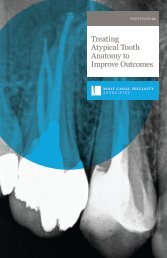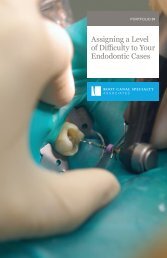Portfolio 02: The Challenge Surrounding Tooth Resorption
You also want an ePaper? Increase the reach of your titles
YUMPU automatically turns print PDFs into web optimized ePapers that Google loves.
THE CHALLENGES OF RESORPTION<br />
Etiology. It is thought that tooth resorption may occur following injuries to or irritation to<br />
the periodontal ligament and/or dental pulp and it is a frequent sequelae following traumatic<br />
injuries, orthodontic tooth movement, or chronic infections of the periodontal structures.<br />
Diagnosis. <strong>The</strong>re may be no external signs, and the resorptive condition is often detected<br />
by routine radiographic examination. Where the lesion is visible, the clinical features vary<br />
from a small defect at the gingival margin to a pink coronal discoloration of the tooth crown<br />
resulting in ultimate cavitation of the overlying enamel. <strong>The</strong> condition is usually painless<br />
unless pulpal or periodontal infection develops. Radiographic features of resorptive lesions<br />
vary from well-delineated to irregularly bordered mottled radiolucencies, and these can be<br />
confused with dental caries.<br />
Treatment. <strong>Resorption</strong> can occur as a single entity or a combination of internal and external<br />
defects can occur simultaneously on the same tooth. Effective management and appropriate<br />
treatment can only be carried out if the true nature, history and exact location of the resorptive<br />
defect is known. Cone Beam Computed Tomography (CBCT) has been shown to be an<br />
important adjunct for the diagnosis and treatment of resorptive defects.<br />
Classification. <strong>The</strong> various types of root resorptive defects have been organized and<br />
classified in a variety of ways. In an attempt to eliminate confusion, a clinical related classification<br />
system based on stimulation factors has been developed and is outlined below:<br />
RESORPTION CLASSIFICATIONS<br />
1. PULPAL INFECTION ROOT RESORPTION (internal and/or external)<br />
2. PERIODONTAL INFECTION ROOT RESORPTION<br />
3. ORTHODONTIC PRESSURE ROOT RESORPTION<br />
4. IMPACTED TOOTH OR TUMOR PRESSURE ROOT RESORPTION<br />
5. ANKYLOTIC ROOT RESORPTION<br />
To learn more about these classifications, reference the article “Root resorption –<br />
diagnosis, classification and treatment choices based on stimulation factors.”<br />
Copyright © Blackwell Munksgaard 2003<br />
If you have questions about this complicated condition or treatment options for your<br />
patient, our doctors are always available for endodontic case consultation.<br />
2





